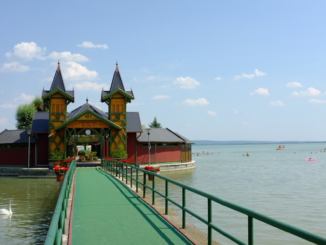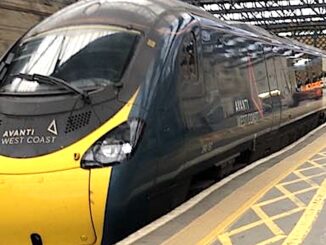In May 1959 The Birmingham Mail introduced my uncle’s latest article as follows:
Where will you find the last pioneers in this age when frontiers are shrinking every day?
In Canada’s Far North – the land of the Mountie and the Indian, the fur trader and the Eskimo. The land where men seek oil and uranium where their fathers sought gold.
This is the world’s last frontier—rough and tough, a mysterious, wild land of immense loneliness … a land you should know more about.
That is why JOHN ALLDRIDGE was sent to Canada. His briefing:
“Go North! Avoid the big cities – we have them here. Go north to the frontier country. Go to bustling Flin Flon and Uranium City, and the trading posts of the Hudson’s Bay Company. Go to Yellow Knife and Fort Resolution, and to the Peace River country…”
These colourful names mark the route of John Alldridge’s Trail of ’59.
Jerry F
To the edge of the world’s Last Frontier

This is the man,
Unknown photographer – Newspapers.com, reproduced with permission
Winnipeg, Friday
I have started an adventure that will take me to one of the world’s mysterious places – the Far North of Canada.
No place on earth is so vast and so empty as these million-and-a-half square miles they call the Yukon and North-West Territories.
You could drop the British Isles in here and never miss them. Only four years ago a flier discovered three new islands in Hudson Bay, one the size of Lancashire.
Where else in the world could you lose a river 190 miles long? That happened to the Hornaday, which flows into the Arctic north of Great Bear Lake. A missionary charted it in 1868. It wasn’t seen again until 1948.
And no white man yet has traced it to its mouth.
Men have travelled these northern seas for almost four centuries; yet they still are not fully mapped.
Lord Tweedsmuir, son of a former governor-general of Canada, travelling in the Hudson Bay’s ship Nacopie, once asked the captain where they were. The captain replied, dryly, that by the latest Admiralty chart they were 150 miles inland…
It is an incredible land of extremes and contrasts. In winter the thermometer drops to 83 below; and in summer soars to 103 above.
In parts of the north in August delphiniums grow six feet high; in others a birch tree takes a hundred years to grow a foot.
This is a giant-size country. There are mountains four miles high, fissures a mile deep, fjords a hundred miles long, glaciers a quarter-of-a-mile thick. Here you find two fresh-water seas each as big as Holland; a single island larger than Sweden, and more lakes than there are in the rest of the world put together.
Empty, cold, harsh, unknown, but always rich in promise, this enormous winterland has helped make Canadians what they are physically, economically, and spiritually – tough.
It is still very much the romantic “Rose Marie” country of the Mountie, the Indian, the fur-trader, the bush pilot and the prospector.
But since the war strange new things have been happening in this strange old world. The Canadian North is now a buffer-state between the Western Hemisphere and the other side of the “cold war.”
Somewhere behind the arctic mists enormous air-fields laid out across the ice, two radar lines, spanning the roof of a continent, form the first line of defence against surprise attack.
And the North means wealth, in a world grown poor. Gold from Yellowknife, uranium from Athabasca, iron from Ungava, pour down from the empty spaces with the furs and the fish and the pulp-wood.
The world is short of lead and zinc; around the Great Slave Lake lie 120,000,000 tons for the digging.
The world is growing dangerously short of oil; mixed with the mysterious tar-sands of Athabasca is enough to supply the whole world for a century.
Far to the north engineers are drilling into mountains, moving whole river beds, to find new sources of power. And strange new names like Kitimat, Knob Lake, Pine Point, Uranium City are peppering the Map: names that – like Klondike 60 years ago – stand for “boom town.”
So the mysterious North is suddenly alive. Not only with troops, and construction crews, and scientists investigating everything from permafrost to the vanishing caribou, but with the ordinary men and women that every pioneer invasion brings with it to a new frontier, the policeman and the school teacher; the shopkeeper and the nurse; the parson and the postman.
This is history repeating itself. These are the great-grandchildren of the Forty-niners, the grandchildren of the men of Ninety-Eight.
Their ancestors found their way by covered wagon and mule train. These new pioneers are flown in by plane. But the basic qualities required are the same: tough-fibred courage, and an enduring faith.
It is these people that I am going to meet. People living on the edge of the world’s Last Frontier.
People, many of them with their roots in Birmingham and Manchester and Glasgow. People very much like you and I.
And there are their new neighbours, the Indian and the Eskimo who have survived alone in this uncharitable world for generations. For them this means a new way of life.
A life that includes steam-heat and supermarkets and juke-boxes…
Come with me and meet them.
Join me on this new “Trail of ’59.”

The ’59 trail,
Unknown photographer – Newspapers.com, reproduced with permission
Reproduced with permission
© 2023 Newspapers.com
Jerry F 2023



